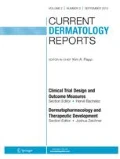Abstract
Vaginal discharge during pregnancy is commonly accompanied by pruritus, malodor, dysuria, or dyspareunia. Almost half of pregnant women are estimated to present with such symptoms. Differential diagnosis is diverse and includes entities that are specific to pregnancy, some of which may pose a hazard to maternal and fetal outcomes. Accurate diagnosis is essential and requires a detailed medical history combined with a thorough genital examination, measurement of vaginal pH, and a microscopic evaluation of vaginal secretions (wet mount). This review will present the approach to diagnosing vaginal complaints during pregnancy, together with the criteria and techniques for diagnosing each of the etiologies.


Similar content being viewed by others
References
Papers of particular interest, published recently, have been highlighted as: •• Of major importance
Fonseca TM, Cesar JA, Mendoza-Sassi RA, Schmidt EB. Pathological vaginal discharge among pregnant women: pattern of occurrence and association in a population-based survey. Obstet Gynecol Int. 2013;2013:590416.
Diseases characterized by vaginal discomfort. Sexual transmitted disease treatment guidelines, 2010 http://www.cdc.gov/std/treatment/2010/vaginal-discharge.htm (last entered May 6 2014).
Anderson MR, Klink K, Cohrssen A. Evaluation of vaginal complaints. JAMA. 2004;291(11):1368–79. A mile stone paper integrating 18 publications calculating the sensitivity, specificity and likelihood ratio of symptoms and signs for evaluating vaginal complaints.
Trichomoniasis and bacterial vaginosis in pregnancy: inadequately managed with the syndromic approach. Bulletin of the World Health Organization http://www.who.int/bulletin/volumes (last entered May 6 2014).
The vulva and vagina manual, Dennerstein G, Scurry J, Brenan J, Allen D, Grazia M. M, Gynederm Publishing 2005.
Kottmel A, Petersen EE. Vaginal wet mount. J Sex Med. 2013;10(11):2616–9.
Williams Obstetric 23rd edition 2010 p.109, 1168.
Workowski KA, Berman S. Centers for Disease Control and Prevention (CDC), Sexually transmitted diseases treatment guidelines, 2010. MMWR Recomm Rep. 2010;59(RR-12):1–110. This is the gold standard for diagnosing and treating sexual transmitted diseases.
Buchanan DL, Kurita T, Taylor JA, Lubahn DB, Cunha GR, Cooke PS. Role of stromal and epithelial estrogen receptors in vaginal epithelial proliferation, stratification and cornification. Endocrinology. 1998;139:4345–52.
Seeds AE, Hellegers AU. Acid-base determinations in human amniotic fluid throughout pregnancy. Am J Obstet Gynecol. 1968;101(2):257.
Lee SE, Park JS, Norwitz ER, Kim KW, Park HS, Jun JK. Measurement of placental alpha-microglobulin-1 in cervicovaginal discharge to diagnose rupture of membranes. Obstet Gynecol. 2007;109(3):634.
Darj E, Lyrenäs S. Insulin-like growth factor binding protein-1, a quick way to detect amniotic fluid. Acta Obstet Gynecol Scand. 1998;77(3):295.
Eriksen NL, Parisi VM, Daoust S, Flamm B, Garite TJ, Cox SM. Fetal fibronectin: a method for detecting the presence of amniotic fluid. Obstet Gynecol. 1992;80(3 Pt 1):451–4.
Newton ER. Chorioamnionitis and intraamniotic infection. Clin Obstet Gynecol. 1993;36(4):795.
Gauthier DW, Meyer WJ. Comparison of gram stain, leukocyte esterase activity, and amniotic fluid glucose concentration in predicting amniotic fluid culture results in preterm premature rupture of membranes. Am J Obstet Gynecol. 1992;167(4 Pt 1):1092.
Mandell: Mandell, Douglas, and Bennett's Principles and Practice of Infectious Diseases, 7th ed. 2009 churchil Livingston.
Centers for disease control and prevention: diagnosing and testing for genital vulvo-vaginal candidiasis http://www.cdc.gov/fungal/diseases/candidiasis/genital/diagnosis.html (last entered MAY 6)
Amsel R, Totten PA, Spiegel CA, Chen KS, Eschenbach DA, Holmes KK. Nonspecific vaginitis: diagnostic criteria and microbial and epidemiologic associations. Am J Med. 1983;74:14–22. This is the classic paper for the clinical criteria of diagnosing bacterial vaginosis.
Nugent RP. J Clin Microbiol. 1991;29:291.
Helander SD, Rogers RS. The sensitivity and specificity of direct immunofluorescence testing in disorders of mucous membranes. J Am Acad Dermatol. 1994;30(1):65.
Sobel JD, Reichman O, Misra D, Yoo W. Prognosis and treatment of desquamative inflammatory vaginitis. Obstet Gynecol. 2011;117(4):850–5.
Gardner HL. “Non specific” vaginitis: a non-entity. Scand J Infec Dis Suppl. 1983;40:7–10.
Compliance with Ethics Guidelines
Conflict of Interest
O Reichman, M Gal, V Leibovici, and A Samueloff declare no conflicts of interest.
Human and Animal Rights and Informed Consent
This article does not contain any studies with human or animal subjects performed by any of the authors.
Author information
Authors and Affiliations
Corresponding author
Rights and permissions
About this article
Cite this article
Reichman, O., Gal, M., Leibovici, V. et al. Evaluation of Vaginal Complaints During Pregnancy: the Approach to Diagnosis. Curr Derm Rep 3, 159–164 (2014). https://doi.org/10.1007/s13671-014-0083-0
Published:
Issue Date:
DOI: https://doi.org/10.1007/s13671-014-0083-0




